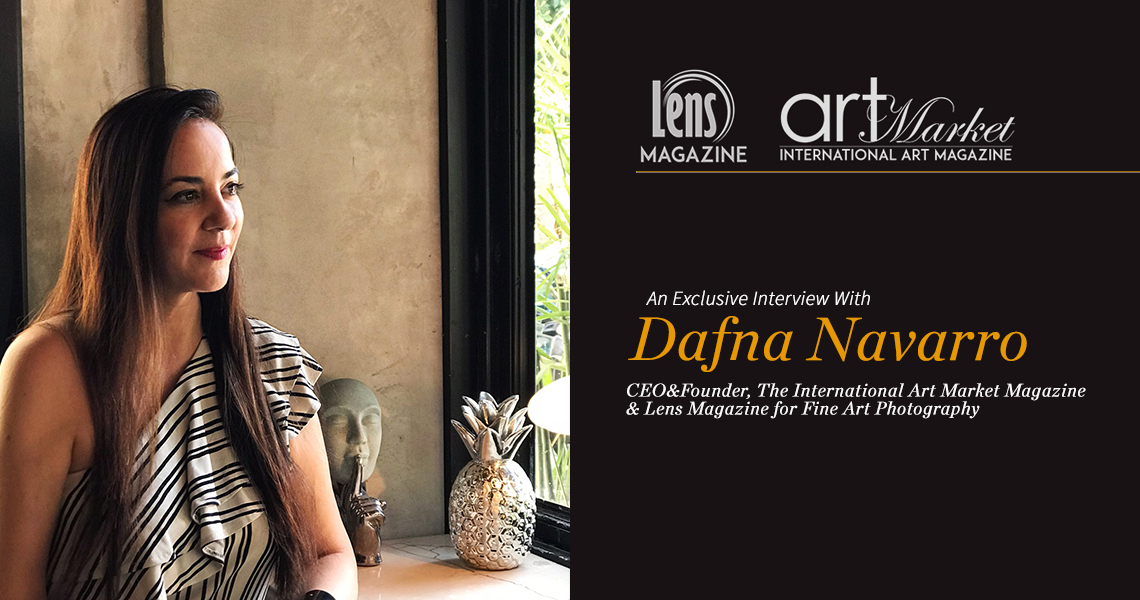
Discovery Art Fair has recently begun a new collaboration with Art Market Magazine and Lens Magazine, who became the Media partners of all three art fairs in Cologne, Frankfurt, and Berlin. Both magazines will feature coverage of the art fairs alongside exclusive interviews with a selection of exhibiting artists and photographers.
It is a pleasure to feature an exclusive interview with the founder and editor-in-chief of these respectable magazines, Dafna Navarro.

Art Market Magazine GOLD LIST Special Edition #5, Featuring Top Contemporary Artists of Today. Published at the end of 2019. Front Cover: Antonie Cordet. Back Cover: SANDRO
Dafna Navarro Background
Dafna Navarro is the CEO and Founder of Art Market – Global Media Company.
Founded in 2013, Art Market is the publisher of two famous international art and photography magazines: Lens Magazine for fine art photography and Art Market Magazine for contemporary fine art, both of which are published and edited by Navarro.
Beyond her many achievements, Navarro is also a curator and an appraiser of art and collectibles. She serves on the jury panel of international competitions in the contemporary art and photography fields.
Navarro is the current editor-in-chief and the main creative driving force behind her magazines’ rise and success. With no signs of slowing down, the magazines feature interviews with the most influential figures in the art and photography fields, coverage of international exhibitions and art fairs – and all the latest news regarding fine and contemporary art from across the globe.
Both magazines are distributed worldwide in both print and digital media. They receive the exposure of over 50,000 readers worldwide, including a full distribution by Barnes & Noble’s book stores in the U.S. and Canada, Steimatzky Bookstores in Israel, and vast appearances in international art fairs. Copies of each published magazine are added to universities’ archive data and to academic libraries as learning material for lecturers and students.
Furthermore, Navarro is also the founder, chief curator, and art appraisals of the Israeli Art Market online gallery featuring an extended collection of contemporary and fine art photography coming from Israel and worldwide.
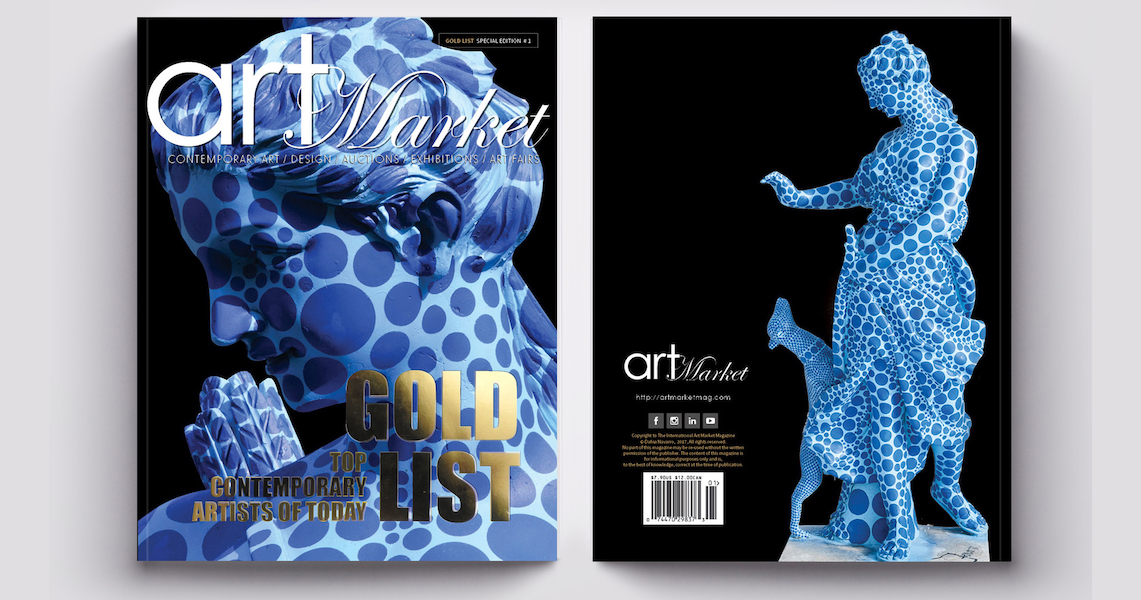
Art Market Magazine GOLD LIST Special Edition #1, Featuring Top Contemporary Artists of Today. Published at the end of 2017. Front and back cover: Feromontana
Interview with Dafna Navarro – by Jasmine Sukary
Jasmine Sukary: Hello, Dafna, it’s a pleasure having you here! You have an awe-inspiring record in the art and photography fields.
First of all, let’s go back to the beginning. Could you please tell us about the process of founding Art Market Magazine and Lens Magazine, and what was the motivation behind their creation?
Dafna Navarro: I founded the magazines in 2014; I first conceived the magazines’ idea to increase sales and exposure of artworks featured on Israeli Art Market, the gallery which I had founded in 2013. But very quickly, both magazines developed their own character and became internationally known publications. The articles highly improved with the help and hard work of excellent professional journalists based in different locations worldwide. These amazing journalists joined my vision of making contemporary art accessible to a larger audience in a more customized and reliable way. At the time, other art magazines focused mainly on the art market’s sales statistics rather than on the artworks themselves.
Naturally, the development created a cohesive and supportive community that appreciates our hard work and innovative style. We’ve also started doing interviews with some of the most influential figures in the art and photography fields, and my main goal was to grow the magazines’ exposure. I believe that any decision to create something should go along with the determination to do it the best way possible. If we are investing entirely and honestly, we must take the most respectable, determined approach all along the way. It is my obligation to invest 100% of my ability. It was a process of building brands that will receive recognition in the art and photography fields. The investment was enormous in any area – both financially and emotionally – as you have to sacrifice much of your personal life to build a strong brand. I’m very proud of both magazines and their development. And I’m very grateful to the people who supported the magazines with their goodwill and positive energy. I feel rather maternal towards my brands; the magazines have a dynamic and evolving creation. They have a life of their own, almost like children growing and evolving with their own personality.
J. S.: How would you describe each of the brands’ artistic styles?
D. N.: Art Market Magazine and Lens Magazine are similar on the one hand but very different on the other. Art Market Magazine is dedicated to the contemporary art field, including art fairs and exhibition coverages and interviews with artists as well as other influential figures in the art world. In contrast, Lens Magazine is dedicated to a different subject each month, featuring solely fine art photography and sometimes more news-related content like war zones photography. For example, the February issue was dedicated to ‘Beautiful and destroyed landscapes.’ It’s a different approach.
On Lens Magazine, I’m investigating and going into the core of each photography field, looking for the best and most respectable photographers in their area and field; We feature genres like documentary, street photography, portraits, fashion, advertising, etc. For each issue, I’m on a mission to find the best content possible for demonstrating a deeper picture of the subject.
In Art Market Magazine, everything is more dynamic and flexible. It is created with the mission to feature the field’s latest, most innovative work. A great example of our inclusive approach is when we had published both an interview with the head of one of the most significant auction houses in the field and fine-art photography features in the same issue.
Since each magazine has its own journalists, each issue is created from a combination of different personalities and points of view. Each journalist brings their own ideas and experience into the final edit.
I could describe the Art Market Magazine as more feminine or with an elegant approach, and the Lens Magazine as a more male approach because of the tough or rigid – deep level of content.
At the same time, they are similar in the quality of the design and in their mission of exploring and showing the love for the creation in art and photography.
J. S.: After hundreds of issues published, what are the main forces still driving you to keep investing and evolving your brands?
D. N.: It must come, first and foremost, from a place of appreciation and love. I’ve studied and explored art, photography, and design all of my life. I have a strong attraction to the art field in general.
I went deeper into each area during the years, including art history, art appraising, antiques, design in all aspects, contemporary art, and photography. Naturally, a fascinating field will draw you to it, and I’m inquisitive and a perfectionist, so the energy to create the magazines comes from deep love. But if we are talking about the everyday energy, also on days that I’m tired, maybe less focused, as every human being has days like that, then my energy comes from my daughters. They give me unbelievable strength to continue if it’s by telling me that they are proud of me, showing interest in what I’m doing, or that they tell me I’m an inspiration to them like my older daughter just mentioned yesterday. Both of them are so involved in the creation of both magazines, they know it’s a central part of my life, in my everyday being. I discuss everything with them – if it’s the distribution, the interviews, or the theme of each issue, and we all grow our knowledge and share the development together.
More exhaustively, inspiration comes from books, music, exhibitions, and the massive information I read every day.
My motivation also comes from seeing the artists’ reactions to their articles or interviews being published. The artists’ joy being notified that their artwork has just been sold, and the good comments and appreciation I’m receiving about the publication every month. That is why I see it as building a community; I feel it as a community of people enjoying my creation, and we all share our love for the field.
J. S.: Do you feel that you’ve reached your goals? Would you describe yourself as a successful person?
D. N.: In the past years, on several occasions, I met people who told me I’ve reached such a success in a short time. Asked me how it is to be a successful person. I’m not sure I know how to answer this question. What is “success”? It is an unclear term. In which aspect? I know I’m doing a great job, but everything we do can be improved in many ways, and I find new goals as things advance, whether it’s allegedly small ones like the printing quality or if it’s the sales and distribution. I have not reached my goal yet, as the goal keeps changing every time you achieve your plan. I feel a lot of satisfaction from the place both magazines are, but there is always plenty of room to grow.
For example, in 2017, when we first started the full distribution to bookstores in the U.S. and saw the enormous list of bookstores located in the U.S., I felt delighted to see and understand the amount of exposure. At that point, I felt the success. Does the feeling last? For five minutes, maybe ten. Immediately after, you start to worry about the advertising and the sales. I think ‘successful feeling’ comes in fractions of moments, as joy and satisfaction—the same way as in life- where everything is so temporary. I am fully aware of my achievements, but I feel uncomfortable looking at myself as a successful person. I hope to leave a mark and to create a change for good in this world. Then it will prove itself as a success. I’m on the way there; that’s why It was important to add the entire content of both magazines to universities archive data and academic libraries worldwide. That the content will remain for future generations, for studies in many years from now. Words and images have the most important meaning.
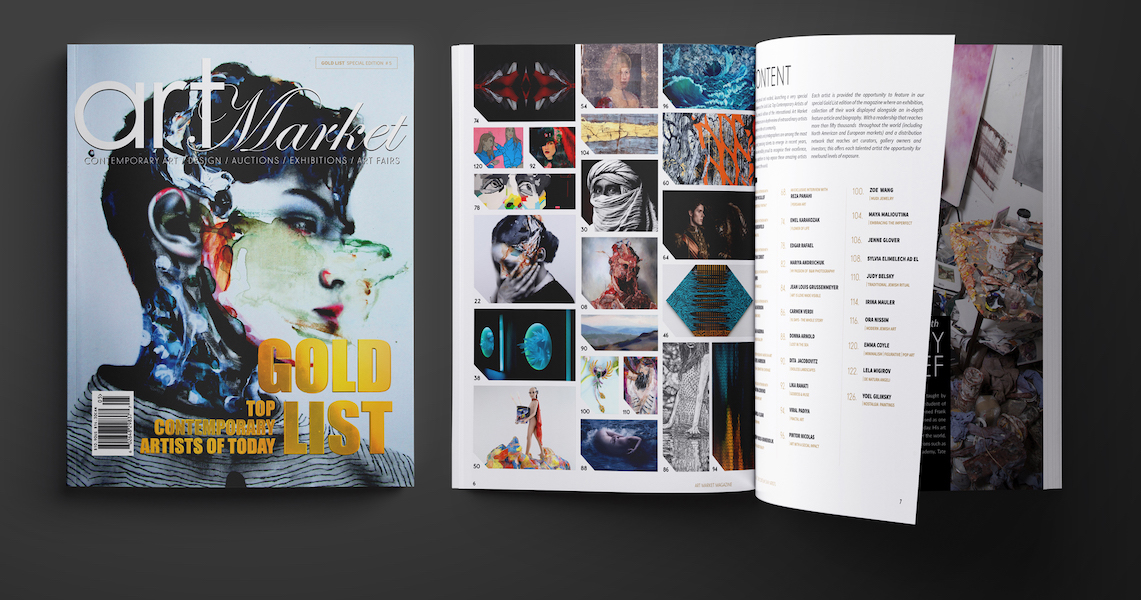
Gold List from Art Market Magazine
J. S.: How do you see the progress and development of Israel’s art field in recent years?
D. N.: I am very aware of the way that Israel has developed in the art field, both locally and internationally. I think the most noticeable development in recent years is in exposure and sales abroad. Artists and photographers receive more exposure in the international art field. The market has opened. Ten years ago, I saw the Israeli art field as a very closed field. Of course, there were auctions and collectors from abroad. Still, it didn’t reach the state we are in today, where artists are exhibiting in international art fairs and are represented by well-known galleries all over the globe. In 2013 I opened the Israeli Art Market gallery; it was the first and only Israeli gallery featuring a massive amount of art intended for the international market. As I created the magazines, we started giving international exposure to Israeli artists and photographers. I am aware of my significance in changing the art field in Israel. The field became more open, with fewer borders, as the interest grew in Israeli contemporary art, Judaica, and fine art photography. Galleries have a better way of presenting the artworks more cleanly and elegantly; the sales grow to private collectors through galleries and auctions. The field has, without a doubt, reached its best position in years.
J. S.: Which direction do you see the art field going in terms of online development?
D. N.: In the past ten years, we can see a tremendous change in the art field. Of course, in the past two years, we are witnessing massive growth in sales online, mainly through auction houses and private galleries, but this is also because of the Covid effect. All this information and statistics are available by Artprice, Artnet, etc. But the most significant change is in the new way of thinking, the perception, where the use of art investments moves to Crypto art. It is an emerging market that revolves around digital artworks traded on blockchains as non-fungible tokens (NFTs). Each piece of crypto art is unique and represented by an NFT with its own value. The use of Bitcoin changed the art world, and it will only evolve and challenge the traditional financial art market. Another change we should pay attention to is virtual reality (V.R.) art, so the whole concept of art investment is now developing in a new direction. In an exciting way, of course.
J. S.: The magazine’s audience comes from all around the globe, including Europe, the USA, Canada, and Middle Eastern countries like Iran, Syria, and Afghanistan. You also publish interviews with artists and photographers based in these middle east countries, which do not have a peace agreement with Israel, where you are currently based. Isn’t it challenging to create these interviews and have personal conversations with artists and photographers from hostile countries like Iran, for example?
D. N.: It gives me great pleasure to feature interviews with artists and photographers from countries like Iran, Syria, Lebanon, and other Middle Eastern countries. Most of them are contacting me or submitting their work through our websites. When their art is exciting and is technically and visually well-made, it’s interesting for me to discover more about their origin, approach to art, and see more of their work. I’m very proud to have the opportunity to introduce them to the international art field. This strong exposure usually leads to good developments and opens doors for them, like quality gallery representation or international prizes. I don’t believe in borders in the art field. Art should not be limited by politics and countries’ borders. So yes, If it’s a gifted artist from Teheran or a photographer based in Syria, I will find a way to organize an interview. It will always be an interesting interview from all aspects, as I’m personally curious to hear their opinion on their country’s culture and their government’s approach to it. Let’s not forget that Islamic art has a very important role in art throughout history. The only limitation I have is with Palestinian art. Here, my hands are tied. And although once in a while I receive a request from a Palestinian artist to represent him or her, to sell their art, I’m not able to help or even be in contact with them. Hopefully, that will change in the upcoming years.
J. S.: What is the Israeli reader’s reaction to these interviews with figures from the ‘Forbidden Connection’ countries?
D. N.: I was inquisitive to see the reactions to these interviews in the beginning. I didn’t see any negative political comments. On the contrary, many Israelis did like the related posts on Facebook and other social media, and had left good remarks. Which is good! I understood that the artistic community and art and culture lovers in Israel are open to a change more than I had assumed. This is when I felt really free to exhibit artists and photographers from all over the world. It’s beautiful!
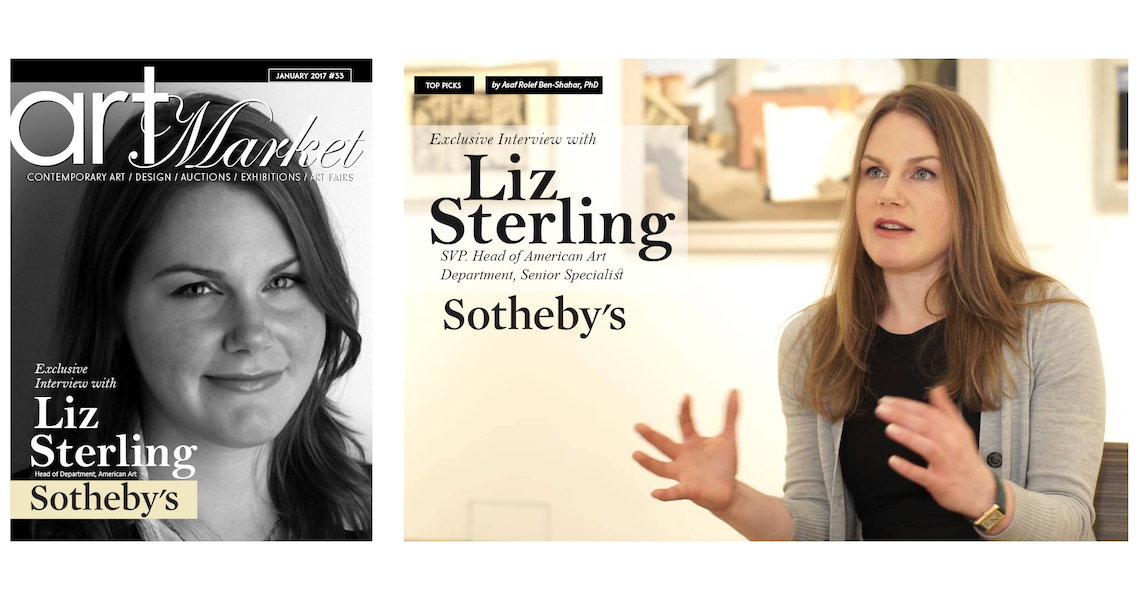
An exclusive interview with Liz Sterling, SVP, Head of American Art Department, Sotheby’s Auction House.
J. S.: Since 2014, you’ve published so many impressive articles and interviews with the most influential figures, both in contemporary art and in the photography field. Can you mention some of the interviews you are the proudest of?
D. N.: There are too many to choose only a few from, but I will try.
Personally, on Art Market Magazine, I was very proud to publish an exclusive interview with Liz Sterling, VSP, Head American Art Department at Sotheby’s, back in January 2017. I enjoyed having an interview with Jeff Koons; we were the first publication coming from Israel that had such a large-scale interview with him. I was very honored to publish an interview with Artnet CEO Jacob Pabst about the international art market. This is just a shortlist that comes to my mind, like a drop in the ocean. In April 2021, we enjoyed an exclusive interview with JÖRGEN GOLZ, Chief Director of one of the largest Art Fairs in Germany- The Discovery Art Fair.
On Lens Magazine, we had so many important interviews with the most influential photographers in the world, such as with Martin Parr. At the same time, he was the CEO of Magnum photography. Lindsay Adler in Fashion, Bob Gruen in Music Photography, and the list can continue for pages. One interview was a very profound and challenging interview with legendary photographer Steve Schapiro about his lifetime achievements as the personal photographer of Kennedy, Barbra Streisand, Martin Luther King, and David Bowie. I decided to interview him myself, in a long conversation of three hours at least. That was a very touching conversation.

An exclusive interview with Jacob Pabst, Artnet CEO.
J. S.: Tell us about the process of choosing the articles and interviews. Do the artists and photographers contact you? What are the parameters for selecting who will get international exposure?
D. N.: Each month we announce the “Submission Open” on all of our social media channels and the newsletter, which reaches over 30 thousand subscribers. Most of the artists and photographers are submitting their work through our websites. So we receive hundreds of submissions every month, and I’m investing the time to check every artwork, Bio, and website of every artist and photographer. It is definitely not an easy task.
Some artists and photographers’ representative galleries or studio directors contact us directly by email, asking us to consider giving them exposure.
The parameters of choosing an artist are, first and, foremost- the quality of the art. Even if the artist is very young, without an impressive resume of solo exhibitions in prestigious galleries or museums, but their art is unique, technically well made, fascinating in its visual and idea, and flowing as a direct line of style – if all these criteria appear – just then I will start to do a full background check of the artist. I will visit their personal website, social media and read their entire resume and previously published information about the artist. So it’s comprehensive research. The chosen artists and photographers are selected very carefully because of the limited space in each issue, and the international exposure is enormous and respectable. My mission is to ensure that each issue is full of quality, unique, and surprising content.
J. S.: Are you a collector yourself? What is your most favorite style of art?
D. N.: I have a small collection of contemporary art, mainly by Israeli artists. But I don’t see myself as a collector in the full term of the word since I’m not on a continuous search for new artworks to purchase. I’m also very interested in limited and first editions of books, and I have a very unique, precise selection of first editions myself. There are several fields I’m really passionate about – art, first editions of books, and antique maps and jewelry, of course. I can’t point precisely on a favorite visual art style; I love many artistic streams, whether it’s the Masters’ work, Islamic Art, Modern art, and contemporary. I’m attracted to such a range of fields that I can not choose a specific style or artist. And every day, the range is growing, as I discover more and more pieces and artists.
J. S.: What does the future hold? Where would you like to see the magazines and yourself in two-three years from now?
D. N.: First, I hope to see the world recovering from this challenging time of Covid. Then, we still have many areas to evolve in, such as a distribution in Europe and Islamic countries.
I want to see the magazines being strongly distributed in the UAE. Although we already have solid digital exposure in all Islamic countries such as Iran, Lebanon, Syria, Jordan, and other Middle-Eastern countries, the print distribution will be the real achievement. We already featured many artists and photographers from these countries in articles and interviews, but I would like to see the magazines in bookstores, newsstands, and art fairs.
I think this passion for these countries comes from my deep appreciation for Islamic art. I want to understand the art market in these countries in a more profound way. So in two years from now, I will definitely have much more knowledge. Art has its power to unite people, give us a better understanding of culture, and create acceptance and appreciation for diversity.
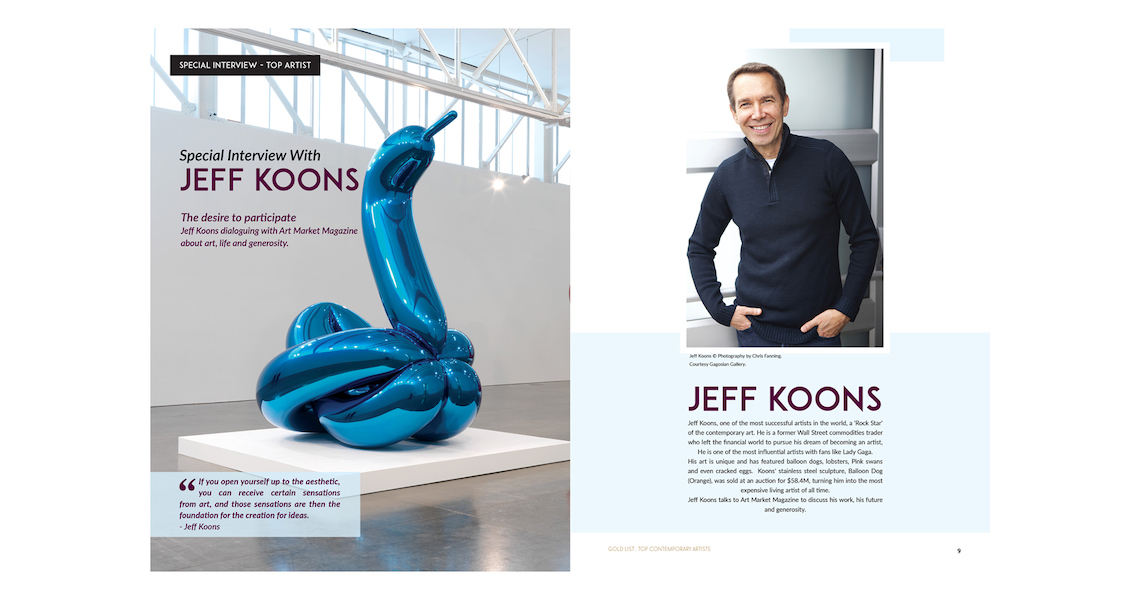
Jeff Koons – Special Interview page


